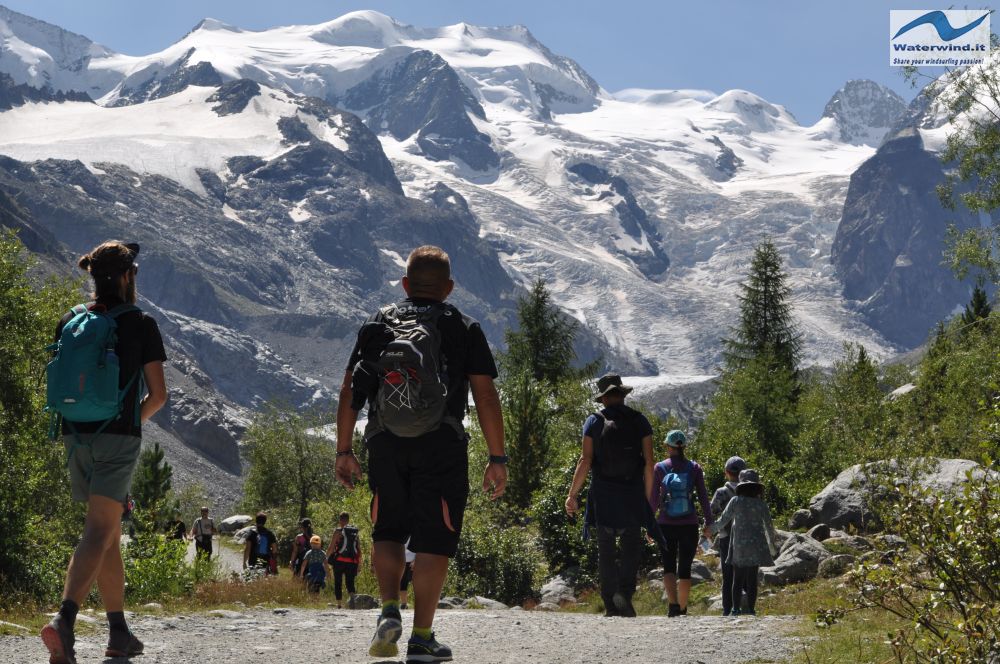Daniele Izzo guides us on the Morteratsch glacier in Engadine (Switzerland), along the 'Sentiero del Sabi', a trek recommended even for the younger ones, which will take us to the base of Mount Bernina.
TREKKING: THE SABI'S PATH, MORTERATSCH GLACIER (ENGADIN, SWITZERLAND)
Imagining a glacier like a giant isn't that difficult once you get in front of it. The colors that range from the green of the trees, the white of the perennial snow and to the blue of the sky, as well as an atmosphere, so distant from everyday life, make a visit to these natural monuments unmissable. Moreover, the Morteratsch glacier in Engadine (Switzerland) is the third longest in the Eastern Alps. So let's discover the 'Sentiero del Sabi' (Sabi's Path), a trek recommended even for the little ones that will take us to the base of the Mount Bernina.
A few kilometers from state border with Italy, where the tricolor flag gives way to the red cross one, lives a sick giant: the Bernina glacier. A part of it, the Morteratsch, can be reached from the 'Sentiero del Sabi': an easy path in the first section, more challenging for the daredevils who want to approach the tongue of the glacier, and which from the station of the famous red train (Bernina express) leads to a close encounter with this wonder of nature.

After leaving the car in the large car park in front of the train station (see map below), the excursion begins immediately with a surprise for the little ones: the possibility of discovering, as you walk alongside the adults, "The great dream of Sabi”: a real treasure hunt thanks to which children can play along the way investigating the magnificent world of the Morteratsch glacier. Therefore, before leaving, do not forget to collect the necessary instructions from the small hut located at the beginning of the trek.
Collected backpacks and instructions, therefore, it's time to leave. Impossible not to see the starting point, the real gateway to the path that leads to the glacier. Having passed the unequivocal monument, one is immediately visually immersed in what will be our trip. To our left, the waters, melted from the perennial snows, flow; to our right, hidden, the right shoulder of the giant, the moraine; in the centre, in front of us, the slightly uphill track.
Step by step, however, the magnificence of the place will be accompanied by another sensation: a mixture of anger and disappointment. Looking up and turning to your right, along the way you will find seemingly harmless, yet significant signs. These are in fact real medical certificates of the ice giant disease. Their goal is to witness the various stages of the retreat of the glacier, which, step by step, will make you realize how much the white glacial mass is suffering from global warming.
It is incredible to think that once upon a time the tongue of the glacier reached the rails of the little red train. And it is equally incredible to think that, as you get closer to the perennial snows, the proximity and frequency of the signs increase dramatically. To give you an example: if in the early 1900s it took 10 or 20 years to retreat 100 meters, in the early 2000s only 5. Impressive. With this perennial sense of amazement. we gradually approach the final point of the stage. Like a dot on a white sheet, we reach the bosom of the moraine. Walls hundreds of meters high envelop us: we are exactly inside the wound of the white giant. In front of us a small waterfall gushes from the earth that protects the lower edges of the glacier tongue; above, all white. It would almost seem to be dreaming, not to be on earth, if it weren't for the sound of the river full of debris that flows where once there was only ice.
However, trying to enjoy this gem at risk for future generations, it is possible to cross the detrital river and climb the steep cliff on the left that leads straight to the snow. From here, it should be emphasized, the route changes completely: from the almost total plain encountered so far, you switch to a steep climb, and from the letter T (tourist path), you switch to E (path for expert trekkers). In fact, after crossing two bridges, you have to struggle between huge boulders, beyond which the route almost no longer exists. Only little piles of stones will come to your aid (stones stacked one on top of the other vertically) who will show you the right way and help you orient yourself until you caress the suffering giant with your hand: the Morteratsch glacier.
Have a nice walk, Daniele.
Technical features:
Length: 9.4km
Duration: 4h
Difficulty: T-E
Overall height difference: 744m
Highest point: 2264m
Lowest point: 1888m
Useful tips:
Let's start with the most banal: camera always at hand. As for the water supply and refreshment points, exactly at the start of the route we will find a bar/restaurant. Finally, coming to the advice concerning the route: first of all, don't forget the sunscreen as you arrive at the base of a glacier; second: once you get to the moraine, pay attention to the numerous debris that systematically detaches from the slopes of the melting giant.
Without your Support, Waterwind wouldn't exist. Become our supporter!
If you want to advertise with us, read here, or conctact us.
The slidegallery of the path




